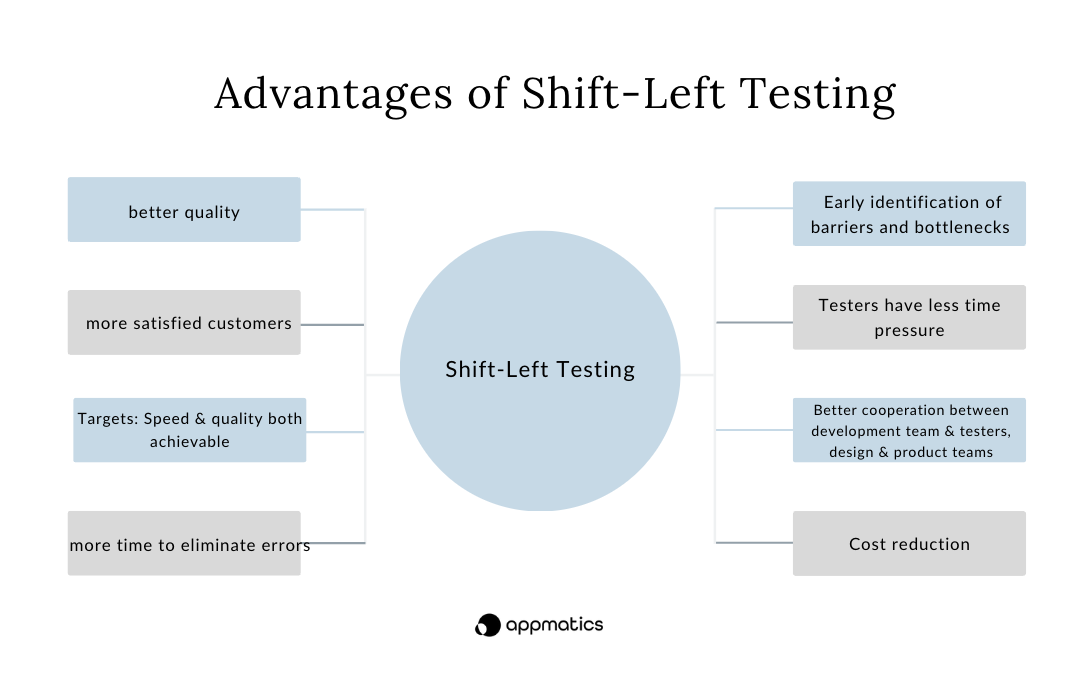Quality assurance and cost reduction at the same time. These are the primary goals of software testing. However, in order to guarantee both, testing must be integrated from the very beginning. And this is done with Shift-Left Testing. What exactly this is and how it works, you can read in the following
What is Shift-Left Testing?
Development cycles are becoming shorter and shorter so that new features can be delivered continuously. However, this means that important time is lost for testing. Shift-Left Testing is intended to counteract this problem by intensively testing important requirements even before development.
Shift-Left Testing pursues the approach of accelerating software testing and facilitating development by starting testing at an earlier point in the development process. "Left" thus stands for the shift of software testing on a timeline and thus refers to an earlier point in the development process. In the shift-left approach, tests are performed multiple times. They are part of the software delivery pipeline and an important component of the DevOps principle.
Shift-left testing not only checks the software, but also the design or important requirements for the software in the first stages of the development process for possible errors. If these are already detected at the beginning of the development process, they can be corrected more quickly and efficiently, which also saves time and costs. In addition, subsequent errors are prevented and the quality of the application is increased right at the beginning.
Shift-left testing is therefore an approach to increase efficiency and to be able to plan workflows better by starting to test the software in the early development stage. In other words, you also test the requirements of the product.
By using the shift-left approach in testing, the quality measures and the testers are integrated into the entire software development cycle. By using the quality assurance measures in the early development stage, such as in the creation of acceptance criteria, the entire software development becomes more efficient and plannable.
Consequently, the sequence of product development with the left shift then looks like this:
- Define requirements
- Testing the requirements
- Defining the design
- Testing the design
- Development of the product
- Testing the product
- Release of the product
Continuous support and communication through shift-left testing
In many projects, the software is only tested when the development is already completely finished. With shift-left testing, on the other hand, there is continuous support for the project or the development from point 0 onwards.
Likewise, communication between the development teams and the QA team takes place not only at critical phases, but throughout the entire development process. In other words, all those involved are involved throughout the entire period of the project. This point is quite important when it comes to efficiency. The fact that the testers are actively involved in the entire process and can thus give immediate feedback prevents errors from being dragged along or repeated. Developers can work on the error in a much more targeted way and make improvements.
Shift-Left Testing: The Advantages
The following advantages can be derived from shift-left testing:
+ testers are involved at an early stage and have less time pressure
+ Better cooperation between the development team and software testers, design and product teams.
+ Possible barriers and bottlenecks are recognised at an early stage. This increases the speed of development, despite increased testing.
+ Costs are reduced through early detection of errors. (Errors that are detected late in the development process cost about 40x more than errors that are detected at the beginning. Source: https://www.tools4ever.de/glossar/was-ist-shift-left/)
+ More time to eliminate the errors
+ Goals: Speed and quality can both be achieved
+ Low risks, more communication and fewer manual errors make for more satisfied customers and a high-quality product
Conclusion: Shift-Left Testing as a Support Tool
In summary, it can be said that the shift-left approach is a very good tool for ensuring software quality despite the high speed of development. In addition, the QA and development teams are in close contact throughout the entire process, which makes it possible to quickly correct errors and thus reduce costs. The direct involvement of the testers also ensures that sufficient resources are available for testing.
Are you interested in Shift-Left Testing or would you like to know more about the process at Appmatics? Then please feel free to contact us. We will be happy to advise you!
